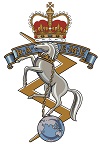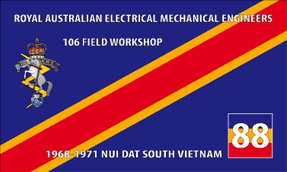1968
Patrol Programming
Milton C. W. Pearson, the CSM of 106 Field Workshop, 1968-1969
The Beginning
I had only been in country for two weeks when my OC W.I.N.S. Hicks-Hall called me in an told me that 106 would be supporting the 4 Bn RAR TAOR patrol program.
At the time of this new duty I had my hands full so I thought the best way to learn how the Battalion operated per their own SOPs was to go out with one of their own nightly patrols.
After contacting the CSM of B Coy 4 RAR "Jock" Richards I learnt that a patrol was heading off for a two day search in the TAOR area the next day.
I arrived in time for the early morning departure in B Coy and had Sgt Noel Crawford with me. I saw Noel as a future patrol commander. Neither of us wore rank and we simply became part of the rifle section for the patrol.
We entered the patrol area where the road turns South towards the "Horseshoe" and went into all round defence. Whilst lying there in the tall grass a young Vietnamese boy appeared from under the ground and commenced to bargain with me for my Australian Bush Hat (my prized possession). I couldn't stop him yapping so I agreed and in exchange I received an American issued multi-pattern bush hat.
We patrolled through the rubber of Long Tan and on leaving the cool of the plantation I now was pushing through 7 foot tall spear grass (elephant grass to some).
We went into a hide for a lunch break and after some time I went forward to see what the delay was. The patrol commander didn`t know his location and was debating with 2IC and members of the patrol who did the pace counting. After some time I intervened and asked for two compasses. Then had the radio operator ring Nui Dat Arty and call for one round smoke. A bearing was taken on the primary gun fire and the second bearing when the round exploded. With two readings the resection proved quite accurate.
I got to know the terrain East of Nui Dat. That night the PC recorded two Defensive Fire Tasks. At about this time I started to scratch my head; whatever was living in the traded bush hat together with my scratching left head sores that lasted for many years. (Asia head lice?).
On completion of the patrol we sought clearance from the Battalion CP prior to re-entering the B Company area through a barbed wire maze that started on the perimeter wire.
Lessons learned during the trip
- Lay of the land and difficulty navigating.
- DF - first round could be called in first up to within 400m (this change later to 1000m)(1).
- Bad tactics in registering two DF's (the enemy could do a re-section also).
- First line ammunition theory went out the door- Carry what you could (not less than 1st line)(2).
- Better idea on how I would implement my own patrol program.
- How casual patrol briefing/debriefing was.
- Design of how I would teach night harbouring for our own patrols.
- Basically - the training I would need to squeeze in to accommodate this activity given our primary role a Field Workshop.
Explanatory Notes
- Defensive Fire is a system that enables a fire task to be recorded to a set grid reference so that during the night if that group were hit then the Patrol Commander could straightway adjust the gun fire onto the position where needed most without having to start from scratch. The artillery formation would have his nightly locstat and the DF so recorded. 2 x DFs if you register a single DF then your location can be N - S - E or West of where that round landed. Enemy night movement would note approximately where the single round landed but have no clue as to direction to go and have a go at you. By registering a second DF it narrows down his search area through his own resection and knowledge of the land.
When I first called in Artillery in Vietnam I was able to have the first round on the ground within 400m of where I thought I was. You would then adjust that single gun fire to where you required the rounds. So adjusting gun fire either Left 50m or Right 50m prior to calling the round towards your position eg, drop 100m, drop 100m, drop 50m. Then when the command was given "Fire for effect" all the guns supporting you would fire a three round salvo ie a battery which is 6 guns would in effect place 18 rounds on the ground to your last call after that you can still call the rounds even closer.For safety reasons the 400m had a safety margin of an additional 600m added after accidents occurred.
In featureless country, in scrub banana or dirty rubber areas there is not a lot to navigate by, only dead reckoning with compass backed up by having pace counters. At each rest period check your location prior to the next leg. The trouble with dead reckoning is that there are trees and other obstacles to navigate around and visibility sometimes makes it hard for the patrol commander to keep his forward scout on a line of march. Without dwelling too much, I found it easier and less demanding to shoot a bearing either to the left or right of a known feature and then, when on reaching that area,simply change direction left or right and proceed until destination was reached. - 1st line ammo was the standard issue for a particular weapon i.e 60rounds for SLR; 400 rounds for the GPMG60 etc (this is an old ammo scale).
When a battle is in progress men like CSMs and RSMs are responsible for the resupply. If a particular sector was being hit and ammo was running low then a redistribution would take place
In Vietnam ammo basically went to what the person was comfortable in carrying. With the belt fed M60 the operator would have about 400 rds. However, the No 2 on the gun would have at least another 600. After that reserves were carried where possible. This made it possible for a sustained fire fight.
Whilst, from early training in the Army, soldiers were taught to count their shots so that they knew the status of the magazine often, in a fire fight, that discipline, if not ingrained, caused problems. The second line ammo was the back up.
Once a radio operator transmitted "Contact" then rear echelons were alerted. Re-supply from second line resources then became the normal practice after contact depending on the next movement of that formation.
The M16 issued in lieu of the F1 had a small grain bullet of .223 cal and, being so light, troops would carry up to two hundred rounds.

